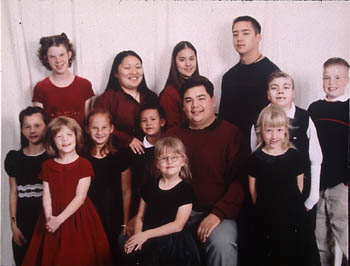![[Metroactive Movies]](/movies/gifs/movies468.gif)
[ Movies Index | Show Times | Silicon Valley | Metroactive Home | Archives ]
Supermom
Jonathan Karsh's documentary 'My Flesh and Blood' looks at an extraordinary family
By Richard von Busack
THE DOCUMENTARY My Flesh and Blood won the Documentary Audience Award and Documentary Directing Award at Sundance, and it's on the fast track for the Best Feature Documentary Oscar. First-time director Jonathan Karsh, a TV reporter for KPIX, kept his head in some troubled situations, as when one of the angriest children you've ever seen confronts him and his camera. But the old TV-made glass wall drops between you and the experience. First thing in the morning and last thing at night, most of us see a parade of disturbing images on television called "the news": snippets of violence interspersed with celebrity trivia and the weather. Laid out before you, in easy-to-digest nuggets, is all the pain within a 500-mile radius: the accidents, homicides and babycides. It's easy to get inured--how could you survive if you didn't? And My Flesh and Blood feels like TV news. It seeks the sad montage--and the blood and the upbeat ending.
Still, Karsh found a terrific subject: the Toms of Fairfield in Solano County. The film focuses on a professional mom, Susan Tom, who has adopted 11 children with various disabilities (except for first adopted daughter, Margaret, who is just starting community college). From the evidence here, Ms. Tom is a reasonable person who just sort of drifted into parenting on the Costco scale. She seems neither to be a religious or any other kind of fanatic. (Her comment about a year of being filmed is "it was like a year of free therapy.")
The children who stand out aren't the ones who have ordinary disabilities. Tom's gregarious teenage daughter Xenia has no legs, but she's an athlete, seen diving, swimming, jumping rope with her hands. When you see this girl flirting for the camera or clowning around in a backyard Halloween pageant, it seems like she'll never have much worry of being a social outcast. Faith, severely burned in the face, is gentle and optimistic, certain she'll be restored to a normal appearance through plastic surgery.
However, it is son Joe, 15, who becomes the focus of the film--pushing his way to the front, sort of. Joe suffered from cystic fibrosis and a furious case of ADD. He was, essentially, the kid you would have changed your route home from school to avoid running into. The one really exceptional quality of My Flesh and Blood is that it shows you what the other half of a bullying kid's life can be like: we learn how his fury is matched by his need for love and attention.
But the most blighted of Tom's children is Anthony, an uncomplaining child--a 19-year-old struck by a cruel hereditary disease called recessive dystrophic epidermolysis Bullosa. This leaves him raw and skinless. The toughest scenes are Tom changing Anthony's bandages, bathing him in bleached water, performing the heartbreaking task of tormenting a flayed child to try to keep him from getting sicker. Seeing such suffering in children tests one's faith in God. My Flesh in Blood makes up for this loss by renewing your faith in Mom.
[ Silicon Valley | Metroactive Home | Archives ]
Copyright © Metro Publishing Inc. Metroactive is affiliated with the Boulevards Network.
For more information about the San Jose/Silicon Valley area, visit sanjose.com.
![]()

Family Values: Susan Tom of Fairfield has created a family that defies expectations.
My Flesh and Blood (Unrated; 83 min.), a documentary by Jonathan Karsh, opens Friday at the Aquarius in Palo Alto and Camera 3 in San Jose.
Send a letter to the editor about this story to letters@metronews.com.
From the November 27-December 3, 2003 issue of Metro, Silicon Valley's Weekly Newspaper.